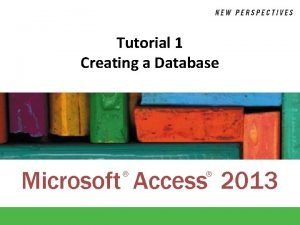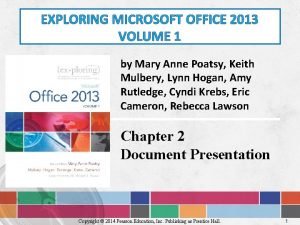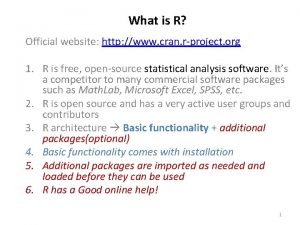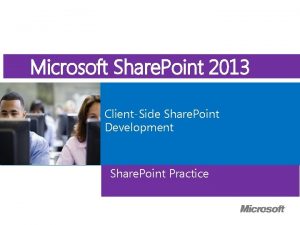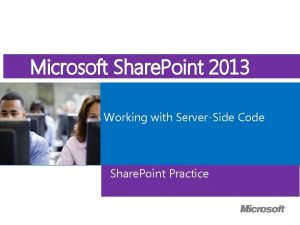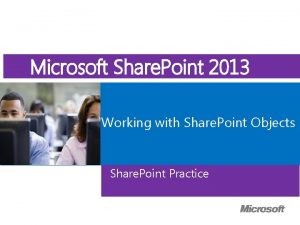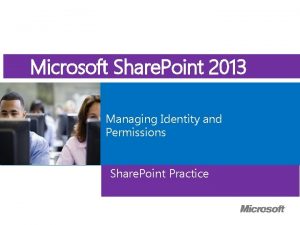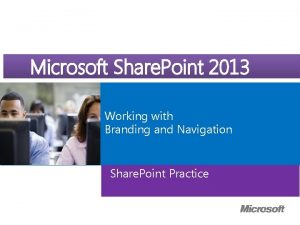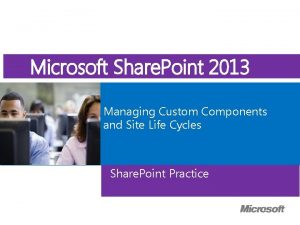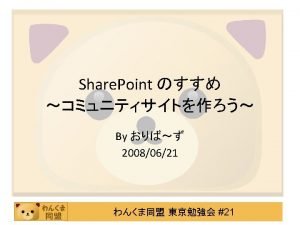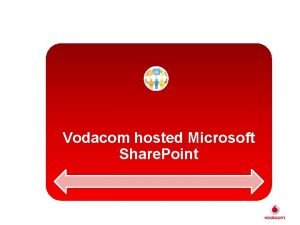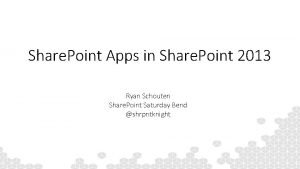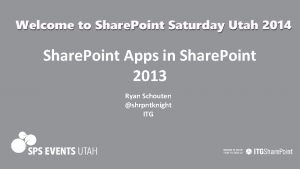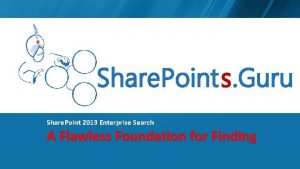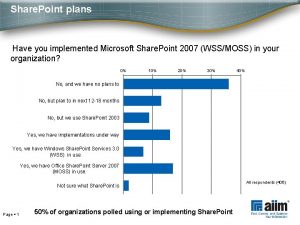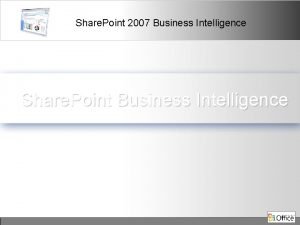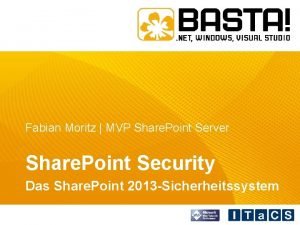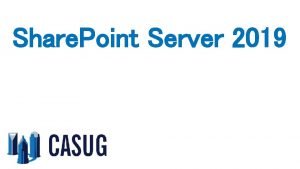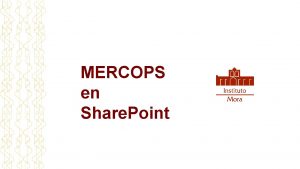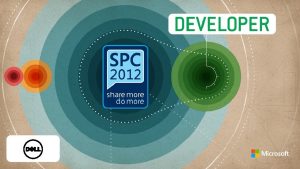Microsoft Course Microsoft Official Share Point 2013 Share





























- Slides: 29

Microsoft Course Microsoft. Official Share. Point 2013 ® Share. Point 2013 as a Developer Platform Share. Point Practice

Module Overview • Introducing the Share. Point Developer Landscape • Choosing Approaches to Share. Point Development • Understanding Share. Point 2013 Deployment and Execution Models

Lesson 1: Introducing the Share. Point Developer Landscape • Share. Point Server 2013 Workloads • Developer Tools for Share. Point Server 2013 • What's New for Developers in Share. Point 2013 • The Share. Point 2013 Technology Stack • The Share. Point Page Rendering Process • Discussion: Page Rendering in Share. Point • Entry Points for Developers in Share. Point 2013 • Demonstration: Developer Tools for Share. Point 2013 • Troubleshooting and Debugging Share. Point Solutions

Share. Point Server 2013 Workloads • Portals and collaboration • Search • Enterprise Content Management • Web Content Management • Social and communities • Business Connectivity Services • Business Intelligence

Developer Tools for Share. Point Server 2013 • Microsoft Visual Studio 2012 • Microsoft Office Tools for Visual Studio 2012 • “Napa” Office 365 Development Tools • Microsoft Share. Point Designer 2013 • Web-design tools

What's New for Developers in Share. Point 2013 • The apps for Share. Point model • New client-side programming models Java. Script • . NET Framework client • Silverlight/Mobile • REST/OData endpoints • • New design model • New workflow model • Other key enhancements

The Share. Point 2013 Technology Stack Share. Point Server 2013 Office Web Apps Server 2013 IIS 8 and ASP. NET 4. 0 Share. Point Foundation 2013 Workflow Manager 1. 0 . NET Framework 4. 5 Windows Server/Windows Azure

The Share. Point Page Rendering Process • Application pages • Physical page on file system • Content pages • Virtual page in content database • Customized content pages Ghosting and unghosting • Safe mode parser •

Discussion: Page Rendering in Share. Point • Is a Web Part page a content page or an application page? • Why might you want to deploy a custom application page to a Share. Point environment?

Entry Points for Developers in Share. Point 2013 • Server-side object model Managed code • Windows Power. Shell • • Client. svc REST/OData clients • Client-side object models • • Declarative customizations

Demonstration: Developer Tools for Share. Point 2013 In this demonstration, you will see a brief overview of the developer tools for Share. Point 2013.

Troubleshooting and Debugging Share. Point Solutions • Modify Web. config to access detailed error information: custom. Errors element • Safe. Mode element • • Use logs to access further information: Windows Application Event Log • Trace logs • • Attach the Visual Studio debugger to debug code

Lesson 2: Choosing Approaches to Share. Point Development • Declarative Components • Client-Side Code • Web Parts • Application Pages • Timer Jobs • Event Receivers • Workflow • Discussion: Choosing a Suitable Development Approach

Declarative Components • Use declarative components to deploy: Site columns • Content types and content type bindings • List templates and list instances • Event registrations and custom actions • Workflows, files, and more • • When should you use declarative components? • Whenever you can • Where can you use declarative components? Share. Point Online • On-premises deployments •

Client-Side Code • Use client-side code to: Interact with core Share. Point artifacts and functionality • Interact with Share. Point Server workloads • Perform almost any operations within the scope of a site collection • • When should you use client-side code? • It is the preferred approach when you need to programmatically interact with a Share. Point site collection • Where can you use client-side code? Share. Point Online • On-premises deployments •

Web Parts • Use Web Parts to: Create custom functionality with user interaction • Connect to other Web Parts • • When should you create Web Parts? Consider apps first • Use Web Parts when you specifically want to leverage the Web Part framework • • Where can you use Web Parts? Share. Point Online (sandboxed solutions only) • On-premises deployments (farm and sandboxed solutions) •

Application Pages • Use custom application pages to: • Expose functionality to every site in a Share. Point farm • When should you create a custom application page? When there are no other options • Consider apps first • • Where can you use custom application pages? On-premises deployments (subject to policy and administrative approval) • Not available for Share. Point Online •

Timer Jobs • Use custom timer jobs to: Run background tasks on a scheduled basis • Process queues of work items on a scheduled basis • • When should you create a custom timer job? When you do not require user interaction • When you want to remove logic from the page load process • • Where can you use custom timer jobs? On-premises deployments (subject to policy and administrative approval) • Not available for Share. Point Online •

Event Receivers • Use event receivers to: • Execute code before or after an action occurs • When should you create an event receiver? When you want to perform custom validation or additional configuration for an action • When you want to perform additional processing after an action occurs • • Where can you use event receivers? Share. Point Online • On-premises deployments •

Workflow • Use workflows to: Automate business processes • Manage the flow of documents and information • • When should you create a workflow? When you need to capture input from multiple users • When you need to create logic that reacts to changes in documents or sites • • Where can you use event receivers? On-premises deployments • Share. Point Online •

Discussion: Choosing a Suitable Development Approach • Review the three scenarios in the student workbook • Which approach to development would you use in each scenario, and why?

Lesson 3: Understanding Share. Point 2013 Deployment and Execution Models • Share. Point Features • Farm Solutions • Sandboxed Solutions • Apps for Share. Point

Share. Point Features • Anatomy of a Feature folder • Feature manifest file • Element manifests • Element files • • Feature deployment Deployment to WFE server file system • Deployment as part of Share. Point app or solution •

Farm Solutions • Anatomy of a farm solution Solution manifest • Assemblies • Files • Features • • Capabilities are unlimited • Deploy any server-side components • Deployment options may be limited Prohibited in Share. Point Online • May be prohibited in on-premises deployments •

Sandboxed Solutions • Structured in the same way as a farm solution • Deployed to a Solutions Gallery • Scoped to a site collection • Functionality is constrained: • Isolated worker process No access to server-side file system • Limited access to Share. Point object model • • Resource consumption governed by quota system • Apps for Share. Point are now the preferred approach

Apps for Share. Point • Distribution Publish to App Catalog • Publish to Office Marketplace • • Encapsulation No server-side code • All Share. Point artifacts hosted within app web • • Development models Share. Point-hosted • Remote-hosted • • Interaction Full page • App part • Command extensions •

Lab: Comparing Web Parts and App Parts • Exercise 1: Creating and Deploying a Share. Point Web Part • Exercise 2: Creating and Deploying a Share. Point App Part

Lab Scenario You have been asked to provide the developer team at Contoso with an overview of how to create and deploy custom Share. Point 2013 components. As part of this process, you will create a simple Web Part in Visual Studio 2012 You will explore the structure of the solution in Visual Studio and then deploy it to your Share. Point development environment. You will then create a simple app part in Visual Studio 2012, explore the solution, and deploy it to your Share. Point development environment.

Module Review and Takeaways • Review Question(s)
 Microsoft official academic course microsoft word 2016
Microsoft official academic course microsoft word 2016 Microsoft official academic course microsoft excel 2016
Microsoft official academic course microsoft excel 2016 Microsoft official academic course microsoft word 2016
Microsoft official academic course microsoft word 2016 Microsoft it academy
Microsoft it academy What is non official compendia
What is non official compendia Simple discourtesy in the course of official duties
Simple discourtesy in the course of official duties Access 2013 tutorial
Access 2013 tutorial Exploring microsoft office 2013 volume 1
Exploring microsoft office 2013 volume 1 Exploring microsoft office 2013
Exploring microsoft office 2013 Microsoft access 2013
Microsoft access 2013 Uraikan tentang efektivitas rumus pada microsoft excel 2013
Uraikan tentang efektivitas rumus pada microsoft excel 2013 Clip art microsoft word 2013
Clip art microsoft word 2013 T junction of stretcher bond
T junction of stretcher bond Course title and course number
Course title and course number Chaine parallèle muscle
Chaine parallèle muscle Balance point on a number line
Balance point on a number line Uel outlook login
Uel outlook login Point-slope form course 3 answer key
Point-slope form course 3 answer key Date line inside address salutation message closing
Date line inside address salutation message closing R official website
R official website Official colors of the rainbow
Official colors of the rainbow Hockey penalty signals
Hockey penalty signals The style of official documents
The style of official documents What is the official name of the country of italy?
What is the official name of the country of italy? Ffa pledge
Ffa pledge How does antony show himself to be ruthless in this scene?
How does antony show himself to be ruthless in this scene? 11 official languages of south africa
11 official languages of south africa Official ping pong rules
Official ping pong rules Inside address example
Inside address example Big data official statistics
Big data official statistics






